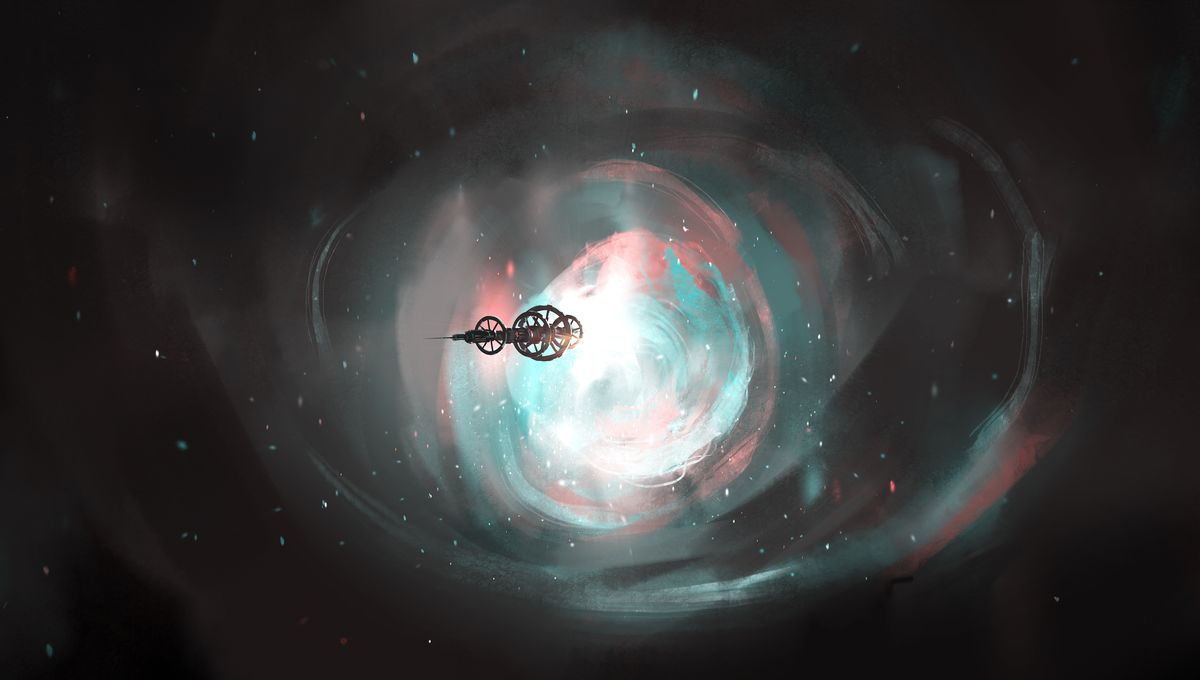Okay just a hot take here, but I don’t think this is the biggest barrier to interstellar travel.
The worst thing about interstellar travel: no internet
Two possible solutions:
- No interstellar travel
- Selfhost everything
I once tried to set up a LAN game of Halo, and let me tell you I’m resigned to staying on earth.
Earth is a massive obstacle to network communication. Move to an o’neill cylinder and never have latency again
Are you suggesting I lead humanity into a golden interstellar post-scarcity future so that I can play halo without lag?
It is your solemn duty!
The best way to play Halo without lag is to make contact with the Covenant. So yeah, to space!
The goal of interstellar travel must be to reduce the ping to 0
Maybe by that point we’ll have actual AI.
Buddy can you imagine all the new alien pron in the new system though?
Also, I don’t think this is anything particularly new. It’s pretty logical of you think about it for a few minutes.
I mean space is pretty empty yea but I feel like it would be a pain in the ass to prevent a ship travelling at light speed from bumping into small to mid sized space debris. On the other hand, I am imagining with this much drive on energy techs we will be at some point able to come up with a solution to the energy requirement to power such a vessel.
It might become like the days of sail. The fastest mode of communication might actually be the speed of ships. In order to get a message between earth and alpha centauri you might have to actually build messenger ships.
You might have to build small automated FTL capable ships with massive data storage capacity and then download all of the data you need to send and then set the ship off on its way.
Never underestimate the bandwidth of a spaceship full of tapes hurtling through the cosmos.
Indeed, it’s the only thing that ever has
Star Citizen has a ship like that. A cabin strapped onto the largest engine that wouldn’t kill you, with data storage added almost like an afterthought.
Well, star citizen has a ship like that - it doesnt have any gameplay loops that make use of that though.
The futuristic version of never underestimate the bandwidth of a station wagon full of tapes hurtling down the highway.
I was hoping the days of sail would be some kind of cool Sci-Fi movie or series.
Data storage ships is a thing in Beacon 23.
No shit.
Have they never watched Star Trek, subspace relays people.
What exactly is subspace anyways?
It’s a different part of the universe, separate from normal space where things like baryonic matter exists. In subspace certain of our universe’s fundamental rules as seen in normal space don’t apply or constants are different.
How much of this is based on reality and how much is based on Star Trek wanting a mechanism to be able to communicate between star fleet and the Enterprise?
I think entirely Star Trek on this one. Although, if we ever want to move* faster than light, it’ll almost certainly require a science or an understanding of nature which we don’t even have theoretical concepts of in 2023.
We use ions for a bunch of stuff like Li-ion batteries and various other chemical engineering marvels on a daily basis. I wonder how new is the idea of ions anyway?
Wikipedia has this to say: “Svante Arrhenius put forth, in his 1884 dissertation, the explanation of the fact that solid crystalline salts dissociate into paired charged particles when dissolved, for which he would win the 1903 Nobel Prize in Chemistry. Arrhenius’ explanation was that in forming a solution, the salt dissociates into Faraday’s ions, he proposed that ions formed even in the absence of an electric current.”
We’ve built so much on top an idea that’s only about 139 years old. Before that, it must have been pretty difficult or even impossible to explain large parts of chemistry we use every day.
I wonder how would you imagine the future of chemistry in the early 1800s? Could you imagine that nowadays we leach gold from a mineral that doesn’t even look golden at all? Could you imagine that we can pull aluminium from rocks that don’t even look metallic in any way? Could you imagine that we use it to build all sorts of things like cans, door frames and airplanes? What about surface coating of materials to give them corrosion resistance, different colors or scratch resistance. In the past 139 years we’ve done all sorts of absolutely wild things with ions.
If you start studying chemistry in 2023 you’ll probably hear about ions during the first lecture and later you’ll build all sorts of wonderful things on that bit of information.
Thanks for this. I have similar thoughts as to some people’s definitiveness about our understanding of the universe and its speed limit.
The thing is, we don’t know is the speed limit is a hard problem.
Maybe will struggle with it for centuries or maybe we’ll find a way to avoid the problem within the next 130 years. Maybe we’ll find a way to bend space so that you don’t really need to travel very fast. Maybe wormholes become a viable option. Maybe we’ll build hyperspace gates or something like that.
Or maybe none of that is viable and a thousand years later we’re still struggling with the speed of light wishing there was a way around it.
At some point, microbes and immunology were a complete mystery. People dying after surgery was a hard problem and nobody knew how to fix that. Turns it, all you need is ethanol and penicillin, but we couldn’t even imagine it at the time.
Space is like a rainbow, subspace is equal to ultraviolet and hyperspace is infrared. At least inmy head cannon.
Subspace is what the warp bubble moves through
Ok, then it’s fictional. The theoretical warp drive that is consistent with Einstein’s field equations moves through normal space but just warps it in a way that it effectively moves faster than light (while locally obeying the light speed limit).
Though that still requires something with negative mass or gravity (I was very disappointed when they confirmed antimatter has normal gravity, I was hoping the theory was wrong on that).
There’s still dark energy and dark matter that are kinda odd
There is the idea that everything is shrinking instead of space expanding, which resolves the dark energy question.
Who would have thought that Doppler could apply to communication equipment, too! Shocking!
Next they are going to tell us that messages might take some time due to c!
That’s what ansible is for, right?
Enders Game reference?
Booo. Orson Scott Card took that term from Ursula K. Le Guin.
I agree, boo to him but I did like that book
wait, what term? “Ansible”?
Yeah
It sure is.
The enemy’s gate is down.
Subspace interference.
Tachyons.
heh, just noticed your username. Excellent 👌
It’s time for a CAKE queue management algorithm with…ahem…interplanetary RTT scheme!
Honestly this seems like a future me problem.
trash site
Most people have missed the bit about time dilation messing up the clocks used in signalling, which I thought was interesting at first. However, surely the fix is just as simple as including a timing signal with the transmissions?
Yeah we solved this problem in the 50s by including a clock signal in some form with the data. Most modern digital communications use it.
I think the problem is less timing the messages, and more that the messages from earth will just get redshifted more and more as the ship accelerates, which will require an ever larger antenna to pick up. This also has the affect of bandwidth tending towards 0.

“뭐?” = “What?” in Korean.
I tried to upload a GIF, but it auto-converted to a PNG. I don’t know if it is Lemmy or my client. You can see it here: https://getyarn.io/yarn-clip/d68f9dba-3745-42d2-a68c-53296b79abed
Ahh, that makes much more sense.

There was an early 2000s anime movie that explored this idea. It was called Voices of a Distant Star.
Quantum Entanglement
Removed by mod
This is why Jesus invented ‘two cans and a piece of string’.
Dammit, I’m not even a trained physicist but I still have to do all the thinking around here.
But where are you going to get a string that long?
Isn’t that what string theory was meant to solve?
Yeah, but they never found the strings, so we don’t pay attention to them anymore. Once they have some testable results we may invite them to the party again.
The fucking string store duh
What’s the propagation speed of vibrations through carbon nantubes? I’ve done no math or experiments but back up this startup tech 100%. I pull on it at Alpha Centauri, it instantaneously pulls a receiver at Sol. I’d say a vat of liquid nylon with a thread pulled and dragged but that sounds sticky.
Edit /s no one is towing a rope
Now I’m imagining spider-ships traversing the galaxy making strings of filament behind them, connecting the galaxy in a vast web of communication lines.
Speed is always the same as the speed of sound through the item
Does a lower frequency signal travel the same speed? 1hz? I suppose it would be the same because the tether would have immense mass over it’s length. So even though I’m picturing an impractically long tether moving as one solid length to tap slow morse code, the mass would be unfathomably high and therefore inducing significant stretch. That’s without getting into vibration kinetic energy being lost to heat along the way
I’m obviously not genuinely proposing this. It’s just a brain exercise.
Jesus Christ, why’d this get so downvoted? Do people not get sarcasm?
I was actually wondering what would happen if you would just put a big rod of metal in 0 g and pushed it? If one end shifts 1 cm, how long would it take for the other end to also shift? Wouldn’t that be instant? Well, apparently the signal would travel at the speed of sound. Which is weird, right? It makes sense but it’s still weird.
It’s mechanical, so each atom is pushing against the ones immediately next to it, and so on, until other end moves.
It would be interesting to work out how much a metal bar the length of our solar system would compress when you push it…















